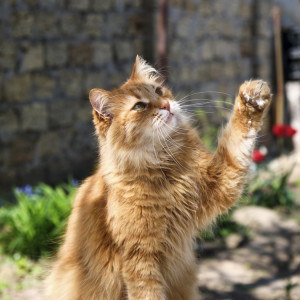Tail Talk: What Is Your Cat Trying to Tell You?
Cats are enigmas. But their tail movements can reveal a lot about their moods

Share Article
Cats use their tails for all sorts of things – from balancing to marking their territory to just generally looking cool. But more than anything, cats wag their tails to communicate, both with humans and with other cats. And while other forms of cat communication can be quite difficult to decipher – Why do you keep meowing at me? I already fed you and cleaned your litter box! – ‘tail talk’ is generally pretty straightforward and easy to understand, according to cat behaviourist and Kinship expert, Cristin Tamburoopens in new tab. “Cats are actually quite communicative creatures,” she says. “And their tails often tell most of the story.” Even a cat biting their tail could be trying to tell you something. Here are 10 cat tail movement meanings.
1. Sticking straight up
As long as your cat’s tail isn’t puffed up, with all the hair sticking out like a pipe cleaner, this is a good thing. Your cat is telling you that they are happy and comfortable and just generally in a good mood. They are strutting their stuff and feeling themselves.
2. The question mark
This is another happy one and often indicates a desire to interact, according to Cristin. So if you see your cat’s tail sticking out with a curl towards the end, take a moment to give them a stroke or a snuggle or a headbutt – or a little play, because they’re ready for it.
3. Straight and puffy
Sometimes paired with an arched back and a hiss, a tail that is puffed up and rigid indicates a cat in distress – one who has either been startled or is feeling in some way threatened. Look where they’re looking and you’ll probably see what’s freaking them out. And if it’s a person, you better believe they did something to deserve it. Cats don’t lie.
4. Wrapped around themselves
Usually, when a cat lies down, their tail will relax away from their body, so when they wrap it close around themselves it could be an indication that they are feeling ill or in some sort of pain. If you notice this behaviour, give them their space but keep an extra close eye on them. Are they eating and drinking like normal? Pooing and peeing at least once a day? Hiding under furniture? Disinterested in play or treats? If this goes on for more than a day or so, call your vet.
5. Wrapped around you
This is sort of the cat equivalent of a hug and is often part of a happy greeting that may include rubbing up against you and contented purring.
6. Fast whipping
A cat tail whip is a sign of fear or aggression and a warning to stay away or stop doing whatever it is that you’re doing.
7. Thumping
Like fast whipping, this is an indication that your cat is angry or, at the very least, annoyed.
8. Slow swishing
Not all motion is bad! A cat swishing their tail from side to side is an indication that they intensely focused, sort of like the way humans sometimes tap their feet when they’re working. Often, you’ll see cats doing this while at play or watching a bird or squirrel through the window.
9. Twitching
Like slow swishing, small, jerky movements of the tail are common during play and hunting. But, according to Cristin, a cat wagging their tail can also be a sign of mild irritation, so use your best judgement.
10. Quivering
Someone’s excited! Like a shiver running down your spine, a cat’s tail quivers when they are particularly well stimulated, like when they see their human after a long absence or when they see another cat. They also tend to do it while spraying, so if you see your cat walking around your yard with their tail all aquiver, probably best to let them finish what they’re doing before running over for a snuggle.
Now, if your cat doesn’t have a tail, perhaps because of an accident, don’t fret. “While it can be challenging for cats to adapt to the loss of their tails, they’re pretty resilient creatures and will generally figure it out,” says Cristin. “For those cats, it’s important to watch their body posture, eyes, ears and whiskers to learn what their tails might tell you otherwise. And, as with any cat, the more time you spend with them, the more familiar you will become with how and what they are trying to communicate.”

Charles Manning
Charles Manning is an actor, writer, and fashion/media consultant living in New York City with his two cats, Pumpkin and Bear.
Related articles

10 Signs Your Cat Has Imprinted On You
Feeling like you have a little shadow these days? A cat behaviourist explains why that’s happening

Why Is My New Cat Not Eating?
A veterinary nutritionist explains the causes, signs and treatment for how to increase their appetite

How to Stop Your Cat From Absolutely Ripping Apart Your Couch
Placing a cat tree or post in a room only, uh, scratches the surface of solving this problem
Your Cat Is Limping. Now What?
When it’s no big deal and when you should worry


